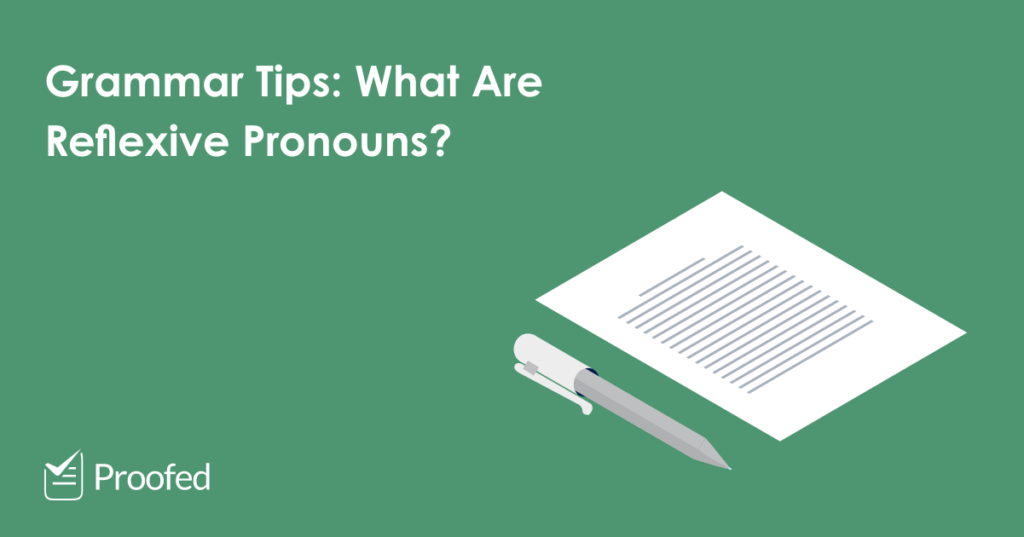Reflexive pronouns let us form sentences where the subject and object are the same thing. But they can be difficult to use correctly, even for native English speakers. Here, then, we’ve prepared a quick guide to how reflexive pronouns work in English so you can avoid errors in your writing.
Reflexive Pronouns in English
There are eight main reflexive pronouns in English. Each is associated with a personal pronoun, and they all end in “-self” or “-selves”:
|
Personal Pronoun(s) |
Reflexive Pronoun |
Example |
|
I, Me |
Myself |
I sat there by myself.
|
|
We, Us |
Ourselves |
We left a note for ourselves.
|
|
You (singular) |
Yourself |
Were you speaking to yourself?
|
|
You (plural) |
Yourselves |
You’ll have to go by yourselves.
|
|
She, Her |
Herself |
She does it for herself.
|
|
He, Him |
Himself |
He bit himself on the lip.
|
|
They, Them |
Themselves |
They keep to themselves.
|
|
It |
Itself |
It must be kept by itself.
|
These words have two main uses in English:
Find this useful?
Subscribe to our newsletter and get writing tips from our editors straight to your inbox.
- To form sentences where the subject and object are the same thing.
- To emphasize who has performed an action in a sentence.
We’ll look at both uses in more detail below.
Reflexive Pronouns as Objects
When the subject (i.e., the person or thing enacting a verb) and the object (i.e., the person or thing being acted upon) of a sentence are the same thing, we use a reflexive pronoun in the place of the object.
This can be a direct object (i.e., the thing being acted on directly):
Jerry looked at himself in the mirror.
Here, for instance, “Jerry” is both the subject (i.e., the person looking) and the object (i.e., the thing he sees) in the sentence, so we use “himself.”
Alternatively, reflexive pronouns can stand in for an indirect object (i.e., the recipient of the direct object in a sentence):
Susan made the sandwich for herself.
In this case, “Susan” is both the subject (i.e., the person making the sandwich) and the indirect object (i.e., its recipient), so we use “herself.”
In all cases, though, when the subject and object of a sentence are the same person or thing, you will want to use a reflexive pronoun to make this clear.
Reflexivity for Emphasis
We can also use reflexive pronouns for emphasis. This is often to emphasize agency in a sentence (i.e, who is acting or who is responsible for an action):
I made the cake myself.
Here, “I made the cake” would make sense by itself. But including “myself” adds emphasis, as if we were saying “without any help from anyone else.”
We can also use it more generally for emphasis, especially to imply importance or to show a contrast between two things. In this case, you would usually give the pronoun immediately after a noun or noun phrase:
David Bowie himself told me the secret to success!
It’s not a great town, but the beach itself is wonderful.
This is a little informal, but it is perfectly acceptable in most forms of writing.
A Common Reflexive Pronoun Error
One common error made when using these terms is using a reflexive pronoun in place of a personal pronoun in a compound subject or object. For instance, some people use “myself” instead of “I” or “me” in a sentence:
Simon and myself have written a book. ✘
Please submit the report to myself and Mr. Harris. ✘
However, since these are not reflexive or emphatic, they are incorrect.
There’s an easy way to spot this kind of error, though. All you need to do is remove the other part of the compound subject or object and see if it sounds right as a singular subject or object instead:
Myself have written a book. ✘
Please submit the report to myself. ✘
We can quickly see that these sentences should say “I have…” and “…to me” instead, respectively. And we can then correct the compound forms, too:
Simon and I have written a book. ✔︎
Please submit the report to me and Mr. Harris. ✔︎
Expert Proofreading for Grammar
Reflexive pronouns can cause a lot of confusion if used incorrectly, so hopefully this post has clarified the basics. To make sure your writing is always at its best, though, why not try our free proofreading trial today?
